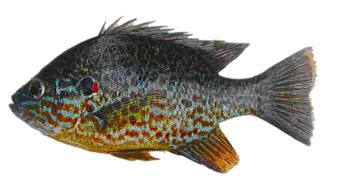Pumpkinseed
Lepomis gibbosus
Report it
If you think you have found an aquatic invasive species:
- do not return the species to the water
- take photos
- note:
- the exact location (GPS coordinates)
- the observation date
- identifying features
- contact us to report it
Identifying features
The Pumpkinseed is a very deep-bodied, laterally compressed, almost disk-like fish. The fish’s breast and belly are orange to red-orange, and its back and sides are brown to olive. Its sides and back are speckled with orange, yellow, blue, and emerald spots.
Similar species (native)
Bluegills (Lepomis macrochirus)
Pumpkinseeds look a lot like bluegills, and they are often found in the same habitat. The best way to tell them apart is by the operculum flap. It is black in both species, but the Pumpkinseed has a distinctive crimson spot in a halfmoon shape on the rear edge. Also, Pumpkinseeds have seven or eight dark, vertical bands on their sides that are more irregular and fainter than those found on the bluegill. Additionally, the Pumpkinseed has several narrow, wavy stripes, alternating orange-brown or light blue.
Where it has been found
It is present in southern B.C. through a combination of intentional introductions and spread from introduced populations in the United States. Pumpkinseed populations are found throughout southern B.C. They have colonized lakes in the Columbia, Thompson, and Fraser River Watershed regions and on southern Vancouver Island.
Habitat
The Pumpkinseed is usually found in quiet, slower moving streams, in the waters of small lakes or ponds, and in the shallow weedy bays of larger lakes. It prefers clear water and areas with submerged vegetation or brush. Pumpkinseeds can be found in large aggregations and often make up the largest portion of the fish population in small, warm bodies of water.
Ecological and economic impacts
The species consumes amphibians and small fish, and contributed to the extirpation of stickleback pairs on Vancouver Island. Pumpkinseed can be considered a nuisance species. The diet of these fish is flexible, and they can reach high densities, compete with native fish, and negatively impact native communities.
Origins and mode of arrival
Native to eastern North America
Mode of dissemination
Extension of Pumpkinseed range in Canada began in the early 1900s, when they were introduced in British Columbia by the Columbia River system. Since then, they have entered the Kootenay River system in British Columbia. This species was introduced for different purposes including control of other fish populations and as forage for predatory species such as largemouth bass. Non-native Pumpkinseed is also found in several lakes on Vancouver Island as well as the lower Fraser Valley.
Government action
Scientific research
Fisheries and Oceans Canada is studying the Pumpkinhead population to improve its understanding of how it reacts and adapts to Canadian conditions.
For further information
- Canadian Science Advisory Secretariat (CSAS) Publications
- Biological Risk Assessment for Northern Pike (Esox lucius), Pumpkinseed (Lepomis gibbosus), and Walleye (Sander vitreus) in British Columbia (CSAS resdocs - 2008/074)
Research document – 2008/074– Fisheries and Oceans Canada - Biological Synopsis of Pumpkinseed (Lepomis gibbosus)
Canadian Manuscript Report of Fisheries and Aquatic Sciences 2886, 2009 – Fisheries and Oceans Canada - Proceedings of the National Workshop on Six Invasive Fishes Risk Assessment in British Columbia; 4-6 March, 2008 (CSAS pro - 2009/040)
- Distribution
- Science Advice from a Risk Assessment of Pumpkinseed (Lepomis gibbosus) in British Columbia (CSAS SAR - 2010/084)
References
- Jordan, C., Backe, N., Wright, M.C., and Tovey, C.P. 2009. Biological synopsis of Pumpkinseed (Lepomis gibbosus). Can. Manuscr. Rep. Fish. Aquat. Sci. 2886: iv + 16 p.
- Date modified:
